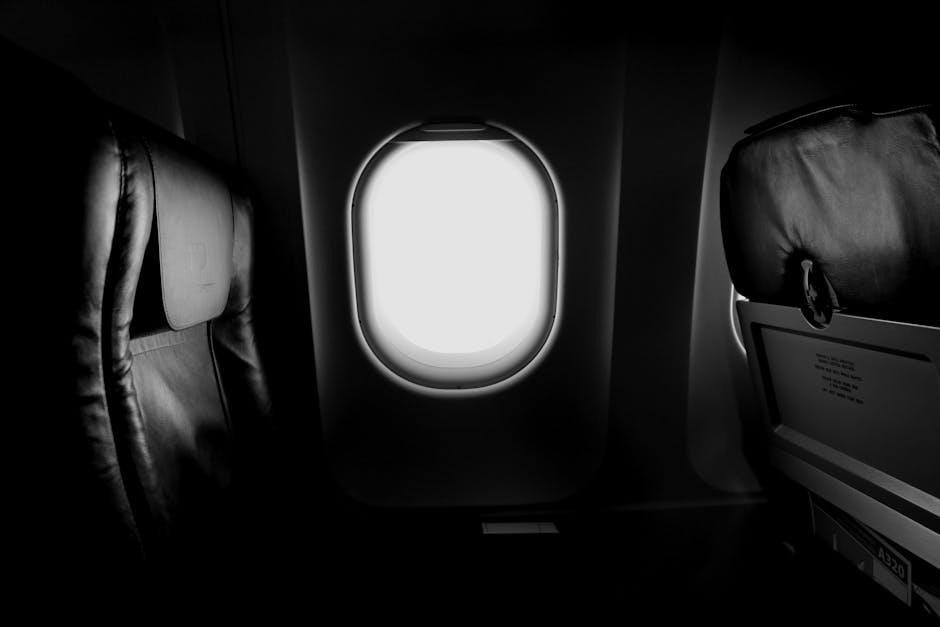Aircraft antennas are crucial for enabling communication, navigation, and surveillance in aviation. They ensure reliable data transmission, enhancing safety and operational efficiency. Proper installation and design are vital for optimal performance.
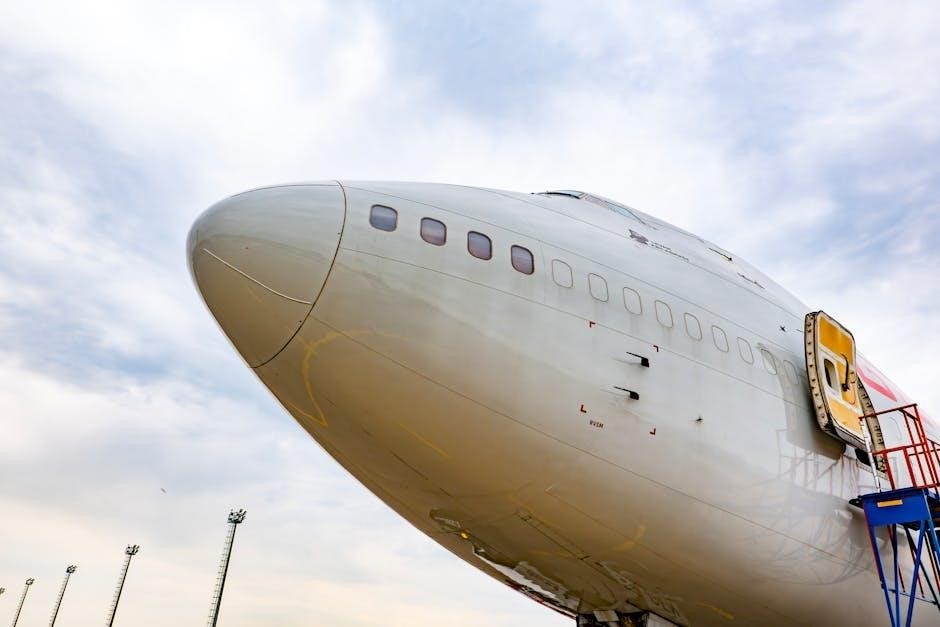
Overview of Aircraft Antennas
Aircraft antennas are specialized communication devices designed to transmit and receive radio signals, ensuring efficient communication, navigation, and surveillance. They operate across various frequency bands, including VHF, UHF, HF, and satellite communication. These antennas are tailored to withstand harsh aviation conditions, such as extreme temperatures and turbulence. Their design must balance performance, aerodynamics, and durability. Proper installation is critical, as poor placement can lead to signal interference or reduced efficiency. Antennas are often integrated with avionics systems, enabling advanced functionalities like GPS, weather radar, and military-specific applications. The market for aircraft antennas is growing, driven by advancements in technology and the demand for reliable connectivity in both civilian and military aviation. Modern designs focus on compact, multi-functional solutions to meet evolving needs.
Importance of Antennas in Aviation
Aircraft antennas are vital for ensuring safe and efficient aviation operations; They enable communication between pilots and air traffic control, navigation systems, and weather radar, which are critical for flight safety. Antennas also support surveillance systems, such as ADS-B, enhancing situational awareness. In military aviation, they facilitate secure communication and tactical operations. Without reliable antennas, aircraft would lack the connectivity needed for modern aviation, leading to potential navigation errors and communication breakdowns. Their role extends to supporting passenger connectivity, such as in-flight Wi-Fi, improving the travel experience. Thus, antennas are indispensable for maintaining operational efficiency, safety, and passenger satisfaction in both civilian and military contexts. Their importance continues to grow with the increasing reliance on advanced avionics and connectivity solutions.
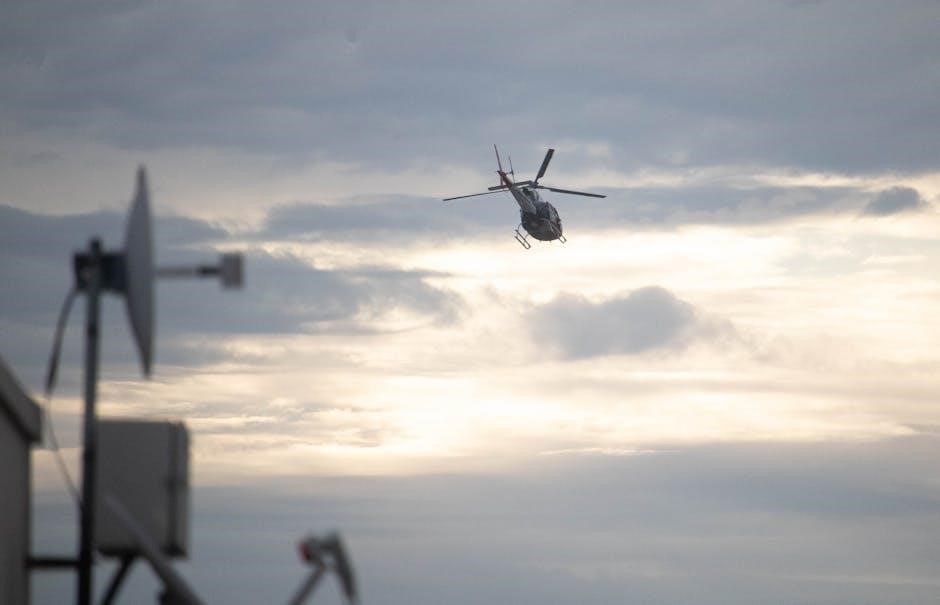
Historical Development of Aircraft Antennas
The development of aircraft antennas dates back to the early 20th century, driven by the need for reliable communication in aviation. Early antennas were simple wire structures, often external and prone to interference. During World War II, the integration of radar systems necessitated more sophisticated designs, leading to the development of directional antennas. The post-war era saw advancements in materials and frequencies, with the introduction of VHF and UHF antennas. Modern antennas now utilize advanced materials like composites and incorporate multi-functional designs to support GPS, satellite communication, and weather radar; Historical innovations have laid the foundation for today’s high-performance, compact, and aerodynamically efficient aircraft antennas, which are essential for safe and connected flight operations. This evolution reflects the continuous adaptation of technology to meet aviation’s growing demands.
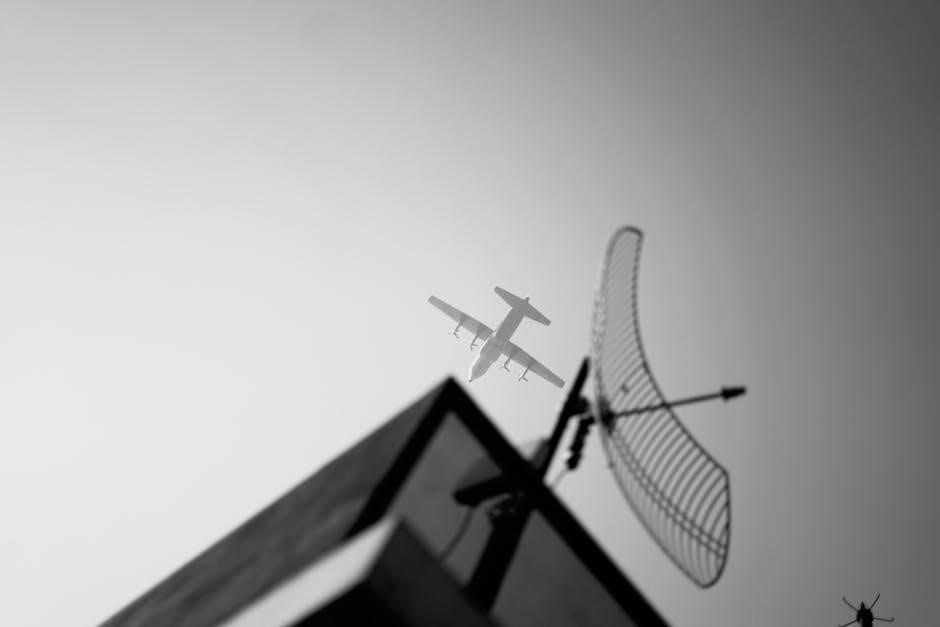
Types of Aircraft Antennas
Aircraft antennas include VHF, UHF, GPS, HF, and satellite communication antennas. Each type serves specific purposes, such as communication, navigation, or weather radar, ensuring efficient aviation operations.

VHF Antennas
VHF (Very High Frequency) antennas are essential for aircraft communication, operating between 118-136 MHz. They facilitate voice and data exchange between aircraft and air traffic control, ensuring safe operations. Common types include blade, whip, and roof-mounted antennas, each designed for specific aircraft models. Blade antennas are popular for their aerodynamic design, minimizing drag, while whip antennas are simple and effective. Proper installation is critical, with considerations like ground plane and minimal interference. VHF antennas are integral for clear communication, especially in busy airspace, making them a cornerstone of aviation safety and efficiency.
GPS Antennas
GPS antennas are critical for aircraft navigation, providing precise location data essential for safe flight operations. They operate on L1 and L2 frequencies, ensuring accurate positioning even in challenging environments. Modern GPS antennas are compact, lightweight, and designed to integrate seamlessly with avionics systems. Many GPS antennas are housed in radomes or low-profile enclosures to reduce drag and enhance aerodynamics. Installation typically requires a clear line-of-sight to satellites, often placed on the aircraft’s roof or wing. Advanced designs incorporate multi-band capabilities and interference mitigation, ensuring reliable performance. GPS antennas are indispensable for modern aviation, enabling precise navigation and enhancing situational awareness for pilots. Their integration with systems like Orbcomm further expands their utility in communication and tracking.
UHF Antennas
UHF (Ultra-High Frequency) antennas are critical for aircraft communication systems, particularly in military and aviation applications. Operating between 300 MHz to 3 GHz, they enable reliable voice and data transmission over short to medium distances. UHF antennas are designed to be compact and durable, often mounted on the aircraft’s skin or integrated into radomes to minimize drag. They are essential for tactical communication, air traffic control, and emergency systems. Modern UHF antennas feature advanced filtering to reduce interference and optimize performance. Their installation requires careful placement to avoid obstructions and ensure optimal coverage. UHF antennas play a vital role in maintaining clear and secure communication, especially in dynamic or hostile environments, making them indispensable for modern aircraft operations.
HF Antennas
HF (High Frequency) antennas are essential for long-range communication in aircraft, functioning between 3 MHz to 30 MHz. They are particularly useful for over-the-horizon communication, enabling connectivity in remote areas with limited infrastructure. HF antennas are typically larger and more complex, often using trailing wires or external structures due to the longer wavelengths they operate on. Despite their size, they are crucial for emergency communication, international air traffic control, and navigation in regions with no satellite coverage. Modern HF antennas incorporate advanced materials to reduce drag and improve efficiency. Their installation requires precise tuning to ensure optimal performance across varying frequencies and environmental conditions. HF antennas remain vital for ensuring reliable communication in remote and high-stakes aviation scenarios.
Satellite Communication Antennas
Satellite communication antennas enable aircraft to maintain real-time connectivity with ground stations and satellites, even in remote or oceanic regions. These antennas are designed to operate at higher frequencies, typically in the L-band or Ku-band, to support voice, data, and internet services. They are often mounted on the aircraft’s fuselage or radome and use advanced materials to minimize drag. Satellite antennas are critical for applications like inflight Wi-Fi, weather data transmission, and emergency communication. Modern designs incorporate phased arrays and compact structures for improved performance. Installation requires precise alignment to ensure optimal signal reception; Satellite antennas are indispensable for enhancing global connectivity and operational efficiency in both commercial and military aviation, ensuring reliable communication regardless of the aircraft’s location.

Installation and Configuration
Proper antenna installation on aircraft requires precise placement, adequate ground planes, and interference reduction techniques to ensure optimal performance and reliable communication systems.

Optimal Placement of Antennas on Aircraft
Optimal antenna placement on aircraft is critical for ensuring reliable communication, navigation, and surveillance. Antennas should be installed in locations providing unobstructed line-of-sight for transmitted or received signals. Preferred positions include the aircraft’s exterior, such as the fuselage, wing tips, or tail, avoiding obstructions like wings or engines. For composite aircraft, internal installation is possible but requires careful consideration of material properties and grounding. A ground plane is essential for monopole antennas, with a minimum size dependent on the antenna’s frequency. Spacing between antennas should be at least 36 inches to minimize interference. Proper placement ensures efficient performance, safety, and compliance with aviation standards, balancing aerodynamic and operational needs.
Ground Plane Requirements for Antennas
Ground plane requirements are essential for ensuring optimal performance of aircraft antennas. A ground plane acts as a reflective surface, enhancing signal strength and directionality. For monopole antennas, a metallic ground plane is crucial, typically extending at least 1/4 wavelength around the antenna. Composite aircraft require alternative grounding methods, such as embedded conductive materials or external grounding plates. Proper sizing and positioning of the ground plane prevent signal loss and interference. It must be large enough to accommodate the antenna’s frequency range. Surface roughness and material conductivity also impact effectiveness. Ensuring the ground plane meets these criteria is vital for reliable communication and navigation systems on aircraft, maintaining safety and operational efficiency across various flight conditions;
Minimizing Interference Between Antennas
Minimizing interference between antennas is critical for maintaining reliable communication and navigation systems on aircraft. Proper placement and spacing of antennas reduce electromagnetic interference (EMI). Antennas should be positioned at least 36 inches apart to minimize signal overlap. Directional antennas can be oriented to avoid conflicting frequency paths. Using filters and impedance-matching devices further reduces cross-talk. Composite materials in modern aircraft require special consideration to prevent signal attenuation. Additionally, installing antennas with minimal line-of-sight obstructions ensures optimal performance. Regular testing and adjustments are necessary to maintain system integrity. By adhering to these guidelines, interference can be effectively mitigated, ensuring clear communication and accurate navigation during flights. This is essential for both civilian and military aircraft operations, where signal clarity is paramount for safety and mission success.
Installation Tips for Composite Aircraft
Installing antennas on composite aircraft requires careful consideration due to the unique properties of the materials. Ground planes should be properly sized and positioned to ensure optimal antenna performance. Internal installation of antennas, such as dipole antennas, minimizes drag and protects the equipment. Composite materials can attenuate signals, so selecting the right antenna type and placement is crucial. Ensure adequate spacing between antennas to avoid interference. For composite fuselages, antennas like the ComDat 248/2480 radome offer a sleek, low-drag solution. Regular testing and adjustment are necessary to maintain signal integrity. Always follow manufacturer guidelines for specific aircraft models to ensure compliance and safety. Proper installation enhances communication, navigation, and overall aircraft functionality.

Design and Engineering Challenges
Aircraft antennas face challenges like size constraints, aerodynamic impact, and material selection. Designing compact, multi-functional antennas while optimizing frequency range and bandwidth is a complex engineering task.
Size Constraints of Aircraft Antennas
Aircraft antennas must be compact to minimize aerodynamic drag and maintain structural integrity. Their size is limited by the aircraft’s surface area and shape, making design challenging. Composite materials often require internal installation, complicating signal transmission. Folding dipoles and compact configurations are used to reduce vertical dimensions while ensuring performance. The trade-off between antenna size and frequency range is critical, as smaller antennas may struggle with lower frequencies. Engineers must balance physical constraints with operational needs, ensuring reliable communication and navigation. These limitations drive innovation in antenna design, focusing on efficiency and multi-functionality to meet modern aviation demands.
Aerodynamic Considerations
Aerodynamic considerations are critical in aircraft antenna design to ensure minimal drag and optimal performance. Antennas must be shaped to align with airflow, reducing turbulence and maintaining aircraft efficiency. Flush-mounted designs are preferred to avoid protrusions that disrupt aerodynamics. Materials and shapes are selected to seamlessly integrate with the aircraft’s surface, preventing air resistance. Placement in low-drag areas, such as wingtips or fuselage, is essential. These considerations ensure that antennas do not compromise the aircraft’s speed or fuel efficiency while maintaining reliable communication and navigation capabilities.
Material Selection for Antenna Construction
Material selection for aircraft antennas is vital for ensuring durability, performance, and compatibility with the aircraft’s structure. Lightweight, corrosion-resistant materials like fiberglass and advanced composites are commonly used to minimize weight while maintaining strength. These materials also provide excellent resistance to environmental factors such as moisture and UV exposure. Conductive materials are chosen for their ability to efficiently transmit and receive signals across various frequency bands. The choice of material must also consider the antenna’s operating frequency, ensuring minimal signal loss. Additionally, materials must integrate seamlessly with the aircraft’s surface to maintain aerodynamic efficiency. This balance of performance, strength, and weight ensures optimal antenna functionality while preserving the aircraft’s overall efficiency and operational capabilities.
Frequency Range and Bandwidth Optimization
Aircraft antennas must operate across a wide range of frequencies to support various communication and navigation systems. The general aircraft frequency range spans from 118.000 MHz to 136.975 MHz, with a bandwidth of approximately 18.975 MHz. Optimizing bandwidth ensures efficient signal transmission and reception, minimizing interference. Modern antennas are designed to handle multiple frequency bands, enabling simultaneous communication, navigation, and surveillance. Advanced engineering techniques, such as impedance matching and filter designs, are employed to maximize performance across desired frequencies. Proper frequency allocation and bandwidth management are critical to avoid signal overlap and ensure reliable connectivity. This optimization enhances overall aircraft communication, navigation, and safety systems, making it a cornerstone of modern avionics design.

Applications of Aircraft Antennas
Aircraft antennas enable communication, navigation, surveillance, and weather radar systems. They are also used in military operations for secure data transmission and advanced radar capabilities.
Communication Systems
Aircraft antennas play a pivotal role in communication systems, enabling seamless voice and data transmission between the aircraft and air traffic control. VHF, UHF, and HF antennas are commonly used for this purpose, ensuring reliable communication over short and long distances. These systems are critical for pilot-air traffic control interactions, navigation instructions, and emergency communications. The design of communication antennas must account for frequency range, bandwidth, and aerodynamic constraints to maintain optimal performance. Proper installation and alignment are essential to minimize interference and ensure clear signal transmission. Advanced communication antennas also support modern avionics systems, enhancing connectivity and reducing signal loss. Their role is indispensable in maintaining safety and efficiency in air travel.
Navigation Systems
Aircraft antennas are essential for navigation systems, providing critical data for precise location and route adherence. GPS and GLONASS antennas are widely used, ensuring accurate positioning and timing. These antennas are designed to operate across multiple frequencies, offering reliable signal reception even in challenging environments. Their compact designs minimize aerodynamic impact while maintaining high performance. Navigation antennas are integrated with avionics systems, enabling real-time data processing for flight control and safety. Advanced materials and designs optimize signal clarity, reducing interference and enhancing accuracy. These systems are vital for safe landings, enroute navigation, and adherence to flight plans. The integration of navigation antennas with modern avionics has revolutionized aviation, ensuring greater reliability and efficiency in flight operations.
Surveillance and Radar Systems
Surveillance and radar systems rely heavily on specialized aircraft antennas to detect and track targets. These antennas are designed to operate across various frequency bands, ensuring wide coverage and high accuracy. Modern radar antennas use advanced materials and designs to minimize interference and optimize signal clarity. They are often integrated with avionics systems, enabling real-time data processing for enhanced situational awareness. Weather radar antennas are also crucial, providing pilots with critical information on weather conditions. The integration of surveillance and radar antennas has significantly improved flight safety and operational efficiency. These systems are essential for both military and civilian aviation, ensuring accurate detection and tracking capabilities in diverse environments.
Weather Radar Antennas
Weather radar antennas are essential for aircraft navigation, providing real-time data on weather conditions. They operate in specific frequency bands to detect precipitation and storms, enhancing flight safety. Modern designs integrate with avionics, offering clear imagery. These antennas are typically installed in the aircraft’s nose or wingtips for optimal coverage. They use advanced materials to withstand harsh conditions, ensuring reliability. Weather radar antennas are vital for pilots to make informed decisions, avoiding turbulence and severe weather. Their integration with other systems has improved overall flight efficiency and safety, making them indispensable in both civilian and military aviation.
Military-Specific Antenna Applications
Military-specific aircraft antennas are designed to meet the unique demands of defense operations. These antennas enable secure communication, navigation, and surveillance in hostile environments. They are built to withstand extreme conditions, including high-speed flight and electromagnetic interference. Military antennas often feature advanced encryption and jamming resistance to ensure reliable performance. Applications include real-time data transmission, radar systems, and satellite communication. They also support mission-critical systems like targeting and electronic countermeasures. Customized for specific aircraft, these antennas enhance situational awareness and operational effectiveness. Their integration with other military systems ensures seamless communication and coordination, making them indispensable for modern military aviation.
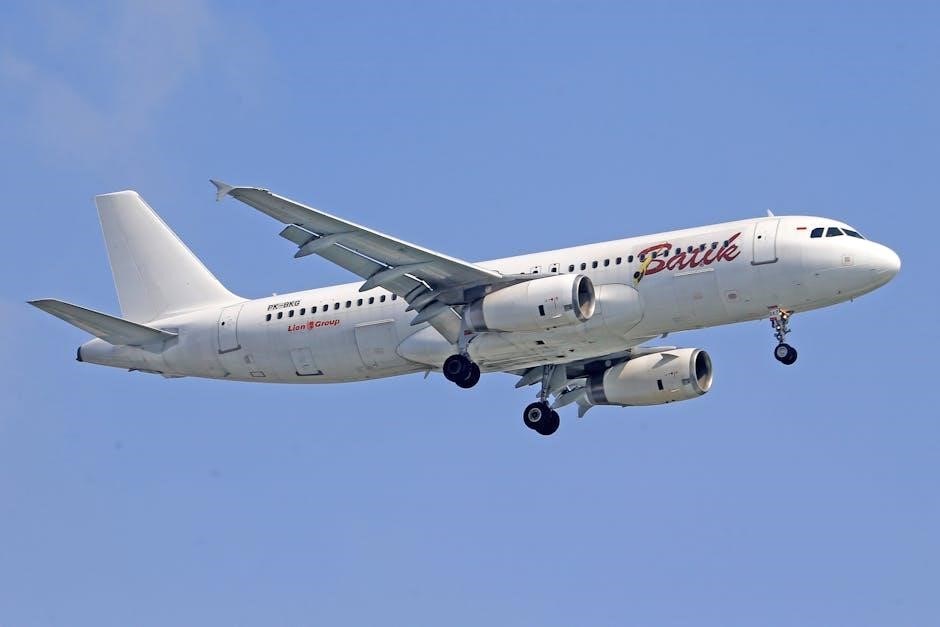
Modern Trends and Innovations
Advancements in aircraft antennas include lightweight materials, multi-functional designs, and integration with avionics. These innovations enhance connectivity, reduce drag, and improve overall performance in modern aviation systems.
Advanced Materials for Antenna Manufacturing
Modern aircraft antennas utilize cutting-edge materials like lightweight composites and high-frequency ceramics. These materials enhance durability while minimizing weight, ensuring optimal aerodynamic performance. Additionally, they support wider bandwidths and reduce signal interference, critical for advanced communication systems. The use of conformal materials allows antennas to be integrated seamlessly into aircraft structures, improving stealth capabilities. Furthermore, these materials withstand harsh environmental conditions, including extreme temperatures and moisture, ensuring reliable operation. Innovations in metamaterials are also being explored to create ultra-compact antennas with superior efficiency; Such advancements are pivotal in meeting the demands of next-generation aviation technologies, where performance, reliability, and integration are paramount.
Integration of Antennas with Avionics Systems
The integration of antennas with avionics systems is critical for seamless communication, navigation, and surveillance. Modern avionics rely on antennas to connect with systems like GPS, weather radar, and communication transceivers. Advanced designs enable antennas to interface directly with avionics, reducing signal loss and enhancing reliability. This integration also allows for real-time data processing, improving situational awareness for pilots. Furthermore, combining antennas with avionics minimizes interference and optimizes bandwidth usage. As avionics evolve, antennas are being designed to support multiple functionalities within a single unit, streamlining aircraft systems. This synergy ensures efficient performance, reduces weight, and enhances overall aircraft operational capabilities. Such advancements are essential for meeting the demands of modern aviation.
Compact and Multi-Functional Antenna Designs
Compact and multi-functional antenna designs are revolutionizing aircraft communication systems. These antennas combine multiple functionalities into a single unit, reducing the need for numerous antennas. By integrating various frequency bands and systems, they optimize performance while minimizing space and weight. Advanced materials and engineering techniques enable these antennas to handle diverse tasks, such as GPS, navigation, and surveillance, simultaneously. This consolidation improves aerodynamics and reduces drag, contributing to fuel efficiency. Additionally, multi-functional designs simplify installation and maintenance, lowering overall costs. As aviation technology advances, these antennas are becoming indispensable for modern aircraft, ensuring reliable connectivity and versatility in demanding environments. Their compact nature also enhances durability, making them suitable for both civil and military applications. This innovation addresses the growing demand for efficient, high-performance antenna solutions in aerospace.
Impact of 5G on Aircraft Communication Antennas
The advent of 5G technology is significantly influencing aircraft communication antennas, driving the need for enhanced connectivity and faster data transmission. 5G enables real-time communication, improved navigation, and seamless integration with avionics systems. However, its high-frequency operation requires antennas to be redesigned for compatibility, ensuring minimal interference and optimal performance. The shift to 5G also demands antennas capable of handling multiple frequency bands simultaneously. This evolution is critical for supporting modern aviation’s growing reliance on high-speed data exchange. Despite the benefits, challenges such as signal interference and compatibility with existing systems must be addressed. The integration of 5G into aircraft antennas promises to revolutionize aviation communication, offering unparalleled efficiency and reliability for future operations.
Market and Industry Insights
The global aircraft antennas market is expanding rapidly, driven by increasing demand for reliable communication and navigation systems. Advanced antennas enhance connectivity and radar performance, with key players like BMS leading innovation. Market reports highlight significant growth potential, supported by emerging technologies and heightened aviation requirements.
Global Market Growth for Aircraft Antennas
The global aircraft antennas market is experiencing significant growth, driven by advancements in avionics and the increasing need for reliable communication systems. The demand for high-performance antennas, particularly for military and commercial aircraft, is rising due to the expansion of air traffic and the adoption of modern navigation technologies. Key players in the industry are investing in research and development to create compact, multi-functional antennas that meet the evolving requirements of the aviation sector. Additionally, the integration of 5G technology into aircraft communication systems is expected to further boost market growth, ensuring enhanced connectivity and efficiency in future aircraft operations.
Key Players in the Aircraft Antenna Industry
Leading companies in the aircraft antenna industry include major manufacturers like BMS, Comant, and others who specialize in designing and producing advanced antenna systems. These companies focus on innovation, delivering high-performance antennas that meet the stringent requirements of both military and commercial aviation. Their products range from VHF and UHF antennas to satellite communication systems, ensuring reliable connectivity and navigation. By leveraging cutting-edge technology and materials, these key players drive market advancements, enabling safer and more efficient aircraft operations. Their contributions are vital to the growth and modernization of the aviation industry.
Emerging Technologies in the Antenna Market
The aircraft antenna market is witnessing significant advancements, driven by emerging technologies such as advanced materials, multi-functional designs, and integration with 5G networks. These innovations aim to enhance performance, reduce size, and improve connectivity. Compact, multi-band antennas are gaining traction, enabling simultaneous support for various communication systems. Additionally, the use of artificial intelligence and machine learning in antenna design is optimizing frequency range and bandwidth. Satellite communication antennas are also evolving, offering higher throughput and reliability for in-flight connectivity. These technologies are reshaping the industry, addressing the growing demand for seamless communication, navigation, and surveillance capabilities in modern aviation.
Aircraft antennas have evolved significantly, playing a critical role in modern aviation. Ongoing advancements promise enhanced connectivity, navigation, and safety, shaping the future of flight.
Future Prospects for Aircraft Antennas
Future aircraft antennas will leverage advanced materials and compact designs to enhance performance. Integration with avionics and 5G technology will improve connectivity and navigation. Innovations like metamaterials and AI-driven designs promise higher efficiency and multi-functionality, reducing size and interference. These advancements will enable better communication, surveillance, and navigation, ensuring safer and more efficient flights. The shift toward composite aircraft necessitates antennas that adapt to new materials, maintaining aerodynamic efficiency. As technology evolves, antennas will play a pivotal role in modernizing aviation systems, addressing emerging challenges and opportunities in the industry.
Challenges and Opportunities in Antenna Development
Aircraft antenna development faces challenges like size constraints, aerodynamic interference, and material limitations. Opportunities arise from advanced materials, such as composites, which enable lightweight and durable designs. Integration with avionics systems and 5G technology promises improved connectivity and efficiency. Innovations like compact, multi-functional antennas address space and performance issues. The growing demand for reliable communication and navigation systems drives market growth, creating opportunities for manufacturers. Despite these advancements, challenges like frequency optimization and minimizing interference remain critical. Balancing these factors is essential for future antenna development, ensuring enhanced performance while meeting aviation’s evolving needs.
